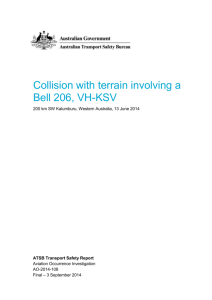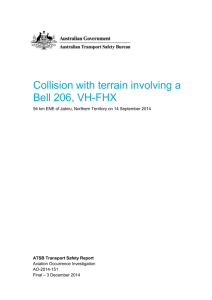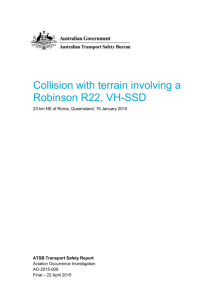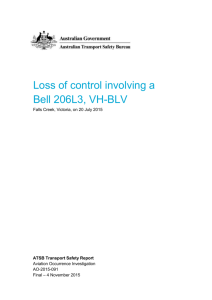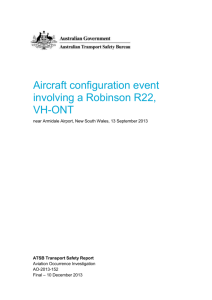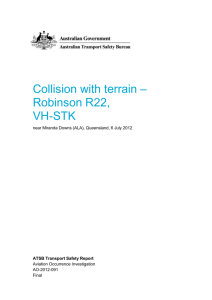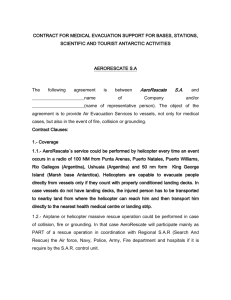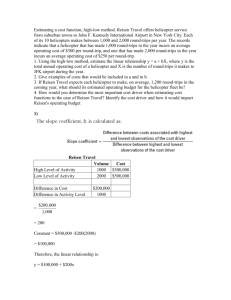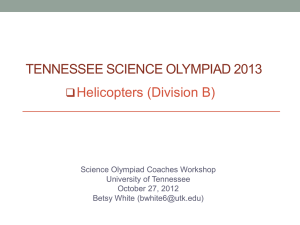DOCX - Australian Transport Safety Bureau
advertisement
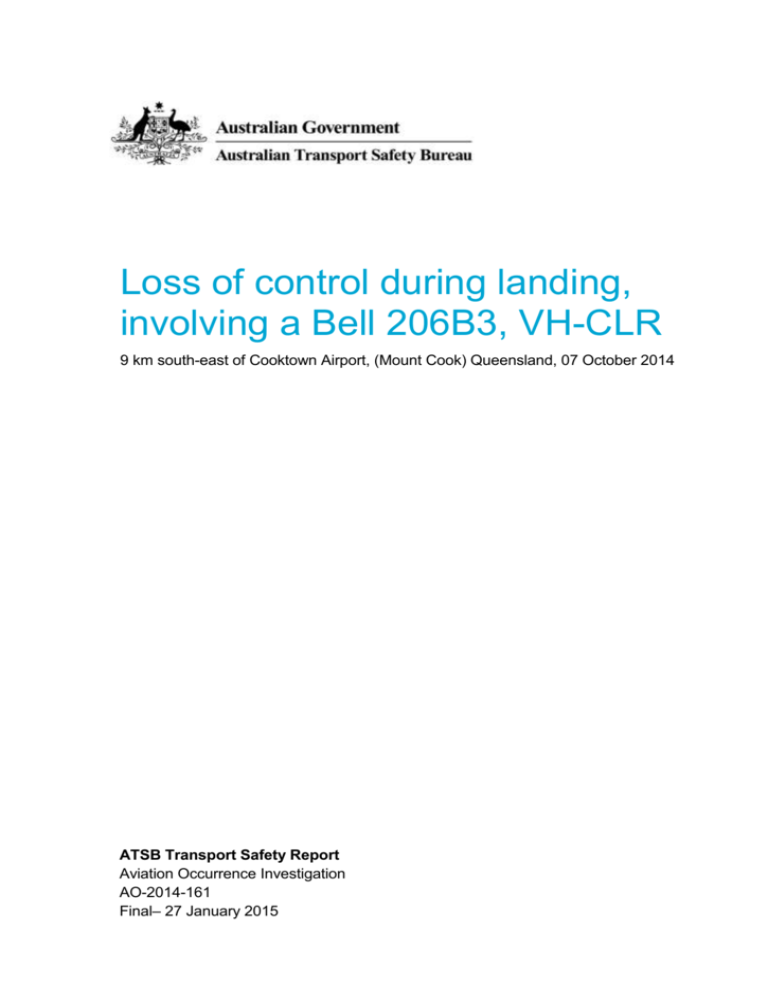
Loss of control during landing, involving a Bell 206B3, VH-CLR 9 km south-east of Cooktown Airport, (Mount Cook) Queensland, 07 October 2014 ATSB Transport Safety Report Aviation Occurrence Investigation AO-2014-161 Final– 27 January 2015 Released in accordance with section 25 of the Transport Safety Investigation Act 2003 Publishing information Published by: Postal address: Office: Telephone: Facsimile: Email: Internet: Australian Transport Safety Bureau PO Box 967, Civic Square ACT 2608 62 Northbourne Avenue Canberra, Australian Capital Territory 2601 1800 020 616, from overseas +61 2 6257 4150 (24 hours) Accident and incident notification: 1800 011 034 (24 hours) 02 6247 3117, from overseas +61 2 6247 3117 atsbinfo@atsb.gov.au www.atsb.gov.au © Commonwealth of Australia 2014 Ownership of intellectual property rights in this publication Unless otherwise noted, copyright (and any other intellectual property rights, if any) in this publication is owned by the Commonwealth of Australia. Creative Commons licence With the exception of the Coat of Arms, ATSB logo, and photos and graphics in which a third party holds copyright, this publication is licensed under a Creative Commons Attribution 3.0 Australia licence. Creative Commons Attribution 3.0 Australia Licence is a standard form license agreement that allows you to copy, distribute, transmit and adapt this publication provided that you attribute the work. The ATSB’s preference is that you attribute this publication (and any material sourced from it) using the following wording: Source: Australian Transport Safety Bureau Copyright in material obtained from other agencies, private individuals or organisations, belongs to those agencies, individuals or organisations. Where you want to use their material you will need to contact them directly. Addendum Page Change Date ATSB – AO-2014-161 Loss of control during landing, involving a Bell 206B3, VH-CLR What happened VH-CLR on Mount Cook On 7 October 2014 at about 0800 Eastern Standard Time, the pilot of a Bell 206B3 helicopter registered VH-CLR, departed Cairns, Queensland with one passenger on board. The purpose of the flight was to conduct a charter flight to Mount Cook, about 9 km south-east of Cooktown Airport, Queensland. As the pilot had not used the landing area previously, he conducted an aerial reconnaissance of Mount Cook prior to arriving at Cooktown Airport to pick up the remaining Source: Queensland Police passengers. In order to assess the conditions, he made 3-4 practice approaches and a practice landing, touching down with the right skid onto the ledge. He assessed that stabilising the helicopter with the right skid for the embarking and disembarking of the passengers would be preferable to the previously decided method of using both skids on the uneven surface. The landing area was a rocky ledge jutting out from the south-eastern side near the top of Mount Cook (Figure 1). After a short break at the airport, and following a passenger safety brief, the pilot conducted two flights up to the landing area on Mount Cook, dropping off a total of five passengers. He reported that the wind during these two flights was estimated to be about 10 knots from the south-east. While waiting back at the airport for the clients to complete their work, the pilot contacted his company to discuss his concerns regarding the greater risk than anticipated of operating onto the landing site. The decision was made to have a full debrief and updated risk assessment of operations at Mount Cook, at the completion of the charter. Figure 1: Approaching to land on Mount Cook (Ground co-ordinator in foreground) Source: Peter Scott ›1‹ ATSB – AO-2014-161 After checking the current wind in the area on the Airservices Australia briefing website, the pilot returned to the Mount Cook landing site at about 1145 to pick up the first load of passengers. By now, the wind had increased to about 14-15 knots. During the approach to land, the pilot reported that he felt the helicopter was stable and appeared unaffected by the increased wind. He was guided into the landing area by the charter client’s ground co-ordinator, who remained in radio contact with him. The ground co-ordinator also managed the loading and unloading of passengers. Although all five people on the ground had initially remained clear, as the helicopter prepared to touchdown, both the ground co-ordinator and one of the passengers planning to board moved closer (Figure 1). Just prior to stabilising the helicopter and touching down on the right skid, the pilot felt it momentarily lift, most likely from a gust of wind, and drift to the right. The right skid then scraped along the rock ledge. The helicopter rolled rapidly onto its right side and slid a short distance forward, prior to coming to rest. The pilot immediately shut down the helicopter and exited through the broken front windscreen. One of the waiting passengers and ground controller had both been struck by the helicopter and the passenger was still trapped underneath; the remaining personnel worked to raise the helicopter sufficiently to allow him to free himself. The ground controller had been knocked unconscious. An ambulance officer in the group called emergency services, and then took over management of the unconscious man. As there was some smoke from the helicopter exhaust, the pilot returned to the cockpit and removed the fire extinguisher, at the same time rechecking that all switches were off. However, he elected not to discharge the fire extinguisher. The pilot and one passenger sustained minor injuries and the ground controller was seriously injured. The helicopter was substantially damaged (Figure 2). Figure 2: VH-CLR post accident Source: Peter Scott ›2‹ ATSB – AO-2014-161 Pilot experience and comments The pilot had about 7,300 hours total flying experience, with about 770 flight hours on the B206. He held the position of chief pilot and chief flying instructor for the company. He was also a Civil Aviation Safety Authority (CASA) approved test officer (ATO). He commented that as he had not landed at the site prior to this day, he had conducted a thorough aerial reconnaissance, including practice approaches in the conditions, prior to landing with the passengers. He had also checked the helicopter tail clearance while manoeuvring during this session. He commented that during the accident approach, the wind was coming from between the 9 o’clock and 12 o’clock positions. Although the trees around the site were showing some effect from the wind, the helicopter appeared unaffected. He had returned from three days off work and was well rested prior to the charter flight. He had consumed food and had kept himself well hydrated throughout the morning. In hindsight, he advised that charter operations should be limited to properly prepared landing sites. He was surprised how quickly the wind had contributed, turning a stable approach into an accident. Operator comments The purpose of the charter flight was to conduct an inspection of the location for a new purpose built helicopter landing site (HLS) which would permit access to telecommunications infrastructure located on the mountain. As the pilot had been on leave for the three days prior to the accident, there had been no opportunity for him to discuss the landing site with the client. He did however have a brief discussion with the deputy chief pilot on the morning of the charter. The Mount Cook HLS had not previously been used by this company, so the client provided details and site photos about it to them. However, the company felt the site photos were a little misleading as they gave the impression that the surface was reasonably flat. The chief and deputy chief pilots decided the best method would be to land on both skids, high up on the rocky outcrop. It was assessed that this would provide a more stable footing for embarking and disembarking the passengers. After the aerial reconnaissance, and noting the uneven surface of the rocky ledge, the pilot altered this decision and elected to only place the right skid on the landing surface. ATSB comment The roll onto the right side by the helicopter is consistent with the phenomenon known as dynamic rollover. When a helicopter rests on one skid, the aircraft may begin rolling, and under certain circumstances it cannot be controlled. This is known as dynamic rollover. Figure 2 shows the forces involved in dynamic rollover. A moment is produced by the horizontal component of total rotor thrust about the point of ground contact of the skid. This moment is opposed by the weight of the helicopter and decreases as the helicopter is placed in progressively steeper banks. The horizontal component of total rotor thrust is related to the angle of bank or roll. Beyond a specific angle of bank it is impossible to stop further roll, and if the helicopter is kept in contact with the ground, it will fall. This angle is known as the critical angle. ›3‹ ATSB – AO-2014-161 Figure 2: Dynamic rollover Source: Principles of Helicopter Flight, 2nd ed., W.J. Wagtendonk The rate at which the roll takes place influences the critical angle. When the right skid is on the ground, tail rotor drift to the right encourages further roll that results in the critical angle being smaller. Any crosswind from the left which causes disc blow-back to the right exacerbates the problem. (Principles of Helicopter Flight, 2nd ed., W.J. Wagtendonk) Safety action Whether or not the ATSB identifies safety issues in the course of an investigation, relevant organisations may proactively initiate safety action in order to reduce their safety risk. The ATSB has been advised of the following proactive safety action in response to this occurrence. Operator As a result of this occurrence, the aircraft operator has advised the ATSB that they have taken proactive safety actions, some of which are listed below: Pre- flight planning For all future charter operations, the company will allow sufficient time prior to the flight to thoroughly research any HLS previously unused by them. A comprehensive risk analysis will be completed, and then a suitable procedure developed for operations at the site. Helicopter landing site Operations at Mount Cook will cease until a helicopter landing pad compliant with Civil Aviation Advisory Publication 92.2.2 (2) has been installed and inspected for use. A review of the register containing all the company HLS will be undertaken. CAAP 92.2.2 (2) is available on the CASA website at: www.casa.gov.au/scripts/nc.dll?WCMS:STANDARD::pc=PC_91054 Commercial Pressure No company pilot, or any other member of staff should ever be subject to undue pressure to complete tasks they judge to be unsafe or outside their individual capabilities. This culture is to be continuously reinforced throughout the organisation. ›4‹ ATSB – AO-2014-161 Communications and Safety Equipment A satellite phone should be included as minimum equipment on any flights north of Mossman and west of Mareeba, Queensland. General details Occurrence details Date and time: 07 October 2014 – 1145 EST Occurrence category: Accident Primary occurrence type: Loss of control Location: 9 km south – east of Cooktown Airport (Mount Cook), Queensland Latitude: 15° 29.22’ S Longitude: 145° 15.42’ E Aircraft details Manufacturer and model: Bell Helicopter Co 206B (111) Registration: VH-CLR Serial number: 3349 Type of operation: Charter Persons on board: Crew – 1 Passengers – Nil Injuries: Crew – Minor Passengers – Nil Persons on ground 1 Minor, 1 serious Damage: Substantial About the ATSB The Australian Transport Safety Bureau (ATSB) is an independent Commonwealth Government statutory agency. The ATSB is governed by a Commission and is entirely separate from transport regulators, policy makers and service providers. The ATSB's function is to improve safety and public confidence in the aviation, marine and rail modes of transport through excellence in: independent investigation of transport accidents and other safety occurrences; safety data recording, analysis and research; and fostering safety awareness, knowledge and action. The ATSB is responsible for investigating accidents and other transport safety matters involving civil aviation, marine and rail operations in Australia that fall within Commonwealth jurisdiction, as well as participating in overseas investigations involving Australian registered aircraft and ships. A primary concern is the safety of commercial transport, with particular regard to fare-paying passenger operations. The ATSB performs its functions in accordance with the provisions of the Transport Safety Investigation Act 2003 and Regulations and, where applicable, relevant international agreements. The object of a safety investigation is to identify and reduce safety-related risk. ATSB investigations determine and communicate the safety factors related to the transport safety matter being investigated. It is not a function of the ATSB to apportion blame or determine liability. At the same time, an investigation report must include factual material of sufficient weight to support the analysis and findings. At all times the ATSB endeavours to balance the use of material that could imply adverse comment with the need to properly explain what happened, and why, in a fair and unbiased manner. ›5‹ ATSB – AO-2014-161 About this report Decisions regarding whether to conduct an investigation, and the scope of an investigation, are based on many factors, including the level of safety benefit likely to be obtained from an investigation. For this occurrence, a limited-scope, fact-gathering investigation was conducted in order to produce a short summary report, and allow for greater industry awareness of potential safety issues and possible safety actions. ›6‹
